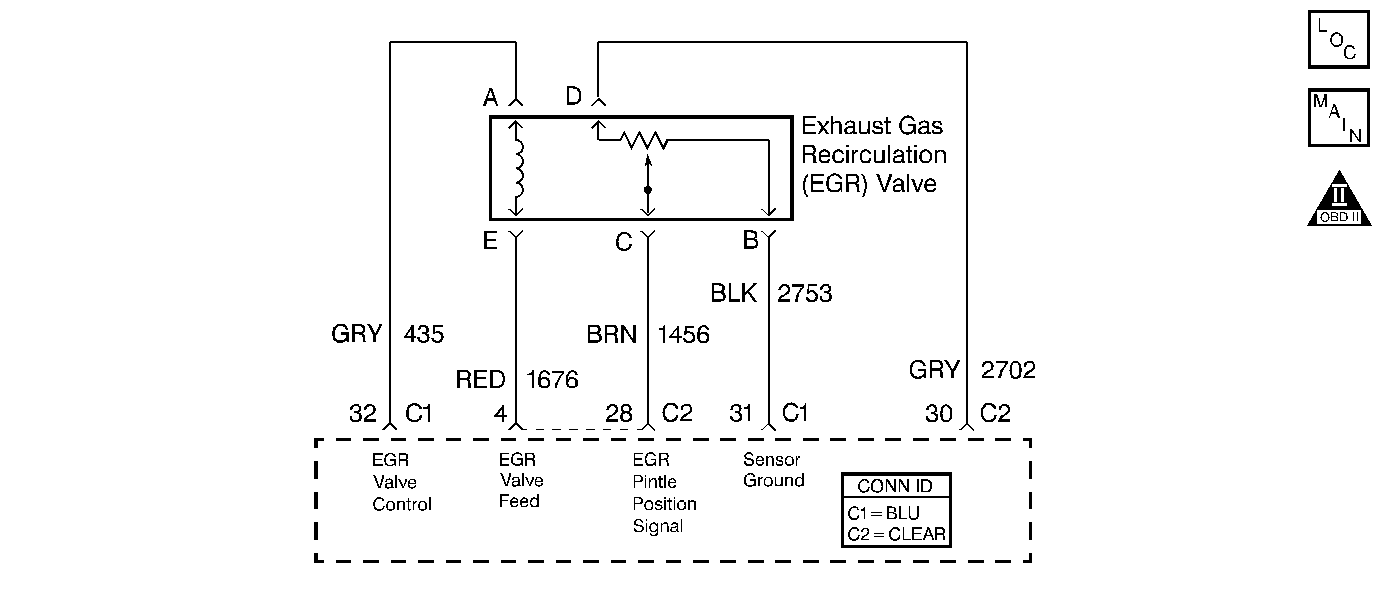
Circuit Description
The PCM tests the EGR system during deceleration by momentarily commanding the EGR valve open while monitoring the Manifold Absolute Pressure (MAP) sensor signal. When the EGR valve is opened, the PCM should see a proportional increase in MAP. If the expected increase in MAP is not seen, the PCM notes the amount of error that was detected and adjusts an internal fail counter towards a fail threshold level. When the fail counter exceeds the fail threshold level, the PCM will set DTC P0401. The number of test samples required to accomplish this may vary according to the amount of detected flow error.
Normally, the PCM will only allow one EGR flow test sample to be taken during an ignition cycle. To aid in verifying a repair, the PCM allows twelve test samples during the first ignition cycle following a scan tool Clear Info or a battery disconnect. Between nine and twelve samples should be sufficient for the PCM to determine adequate EGR flow and pass the EGR test if the system is operating correctly.
Conditions for Setting the DTC
| • | No TP sensor, VSS, Misfire, IAT sensor, MAP sensor, Fuel Injector, Idle speed, EGR Pintle Position sensor, ECT sensor, CKP sensor or MAF sensor DTCs set. |
| • | BARO is greater than 70 kPa. |
| • | Engine coolant temperature is greater than 75°C (167°F). |
| • | Engine speed is between 800 rpm and 1200 rpm and steady. |
| • | IAC position is steady. |
| • | Vehicle speed is greater than 25 MPH and steady. |
| • | TP angle is less than 1%. |
| • | Commanded state of the A/C relay is steady. |
| • | Commanded Transaxle state is steady. |
| • | MAP changes monitored during the EGR flow test indicate insufficient EGR flow. |
Action Taken When the DTC Sets
| • | The PCM will illuminate the malfunction indicator lamp (MIL) during the first trip in which the diagnostic test has been run and failed. |
| • | The PCM will store conditions which were present when the DTC set as Freeze Frame and Failure Records data. |
Conditions for Clearing the MIL/DTC
| • | The PCM will turn OFF the MIL during the third consecutive trip in which the diagnostic has been run and passed. |
| • | The History DTC will clear after 40 consecutive warm-up cycles have occurred without a malfunction. |
| • | The DTC can be cleared by using the scan tool. |
Diagnostic Aids
To verify a repair, clear info with the scan tool and run the EGR flow test keeping the following items in mind:
| • | The PCM will only run the EGR flow test during a gradual deceleration. |
| • | The PCM will only run the EGR test during a closed throttle condition. |
| • | The PCM will only run the EGR test at vehicle speeds above 20 MPH. |
| • | Several deceleration cycles will be necessary to run a sufficient number of EGR flow test samples (9-13). The EGR Test Counter displayed on the scan tool can be useful in determining that the EGR flow test is running and to keep track of the number of test samples taken. The counter will increment each time a test sample is taken. |
Check for the following conditions:
Poor connection or damaged harness. Inspect the wiring harness for damage. If the harness appears to be OK, observe the Actual EGR Position display on the scan tool while moving connectors and wiring harnesses related to the EGR valve. A change in the display will indicate the location of the fault.
Reviewing the Fail Records vehicle mileage since the diagnostic test last failed may help determine how often the condition that caused the DTC to be set occurs. This may assist in diagnosing the condition.
Step | Action | Value(s) | Yes | No | ||||
|---|---|---|---|---|---|---|---|---|
1 | Was the Powertrain OBD System Check performed? | -- | ||||||
2 |
Was a problem found? | -- | ||||||
3 |
Was a problem found? | -- | ||||||
4 |
Was a problem found? | -- | Go to Diagnostic Aids | |||||
5 |
Note test result; does scan tool indicate DTC P0401 Test Ran and Passed? | -- | System OK |
